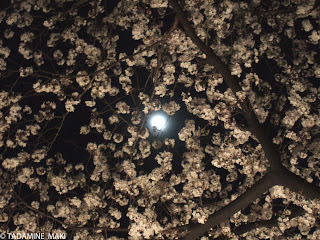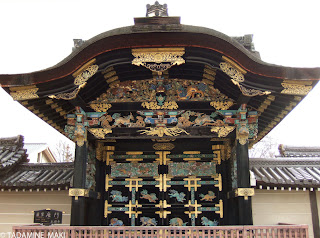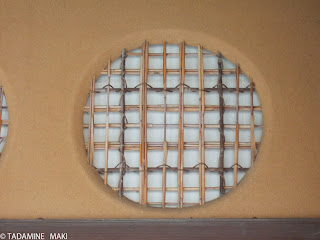Kyoto Daily Photo
This blog is a collection of the photos, showing the daily beauty in Kyoto.
Saturday, March 31, 2007
Friday, March 30, 2007
Thursday, March 29, 2007
Wednesday, March 28, 2007
Tuesday, March 27, 2007
Monday, March 26, 2007
Sunday, March 25, 2007
The smell of well-done socks of a sixteen old boy, natto

Epoisses in France, Durian in South Asia and Surströmming in Sweden.
All the foods are said to be very smelly.
People seem to like smelly food though they smell.
Japan has also some smelly food: one of them is natto, fermented soybeans. Its smell is just like the "well-done" socks before pulling off them for taking a bath. It is made of boiled soybeans and put them into a tube made from straw to allow the natto fungus to increase in number. Some time after, the beans ferment and get sticky. We usually stir it into gruel, add some drops of soy sauce and some finey-chopped raw Welsh onion, called negi in Japanese, and eat it with boiled.
Some says, anybody from the outside of Japan can eat it is compensating for his small weiner.
By the way, I had disliked it for 19 years old. When I was a college student, I always did not have two nickels to rub together. I went to a supermarket to get some healthy and reasonable food and caught sight of this food. This food is cheap and healthy, as well as eggs. After getting the beans, I tried it and did not feel so worse. Since then, I like this food and often eat it for breakfast.
If I have a chance to go to Sweden, I'll try Surstromming!!
PS. The photo below is the beans after stirring.

Labels: food
Saturday, March 24, 2007
Three steps to boiled rice
RIce is essential for us and I eat it every day. The following is three steps to change just rice with chaff to polished rice.
This is rice with chaff.

Without chaff, brown rice comes out. This is rich in Vitamin and food fiber.
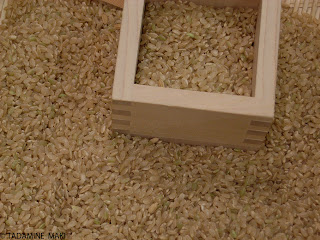
This is polished rice and we usually have boiled one. Most of us prefer polished rice to brown rice.

Friday, March 23, 2007
Thursday, March 22, 2007
Wednesday, March 21, 2007
A cedar ball for new sake, Kyoto

Kyoto is also famous for purity water and with the water is delicious Japanese Sake, alcohol, made there.
This ball is made of cedar and hang in front of Sake breweries through February to March to let people know the new arrival of Sake.
Japanese Sake is mainly made of rice, rice malt and water. Sake is started to make in the beginning of the cold season every year and is finished and ready in Feb. or Mar..
The ball means, "New sake is in ready."
By the way, why is cedar used to make the ball?
Because a tall and big cedar is regarded as a place for a god of sake in Miwa shrine, famous for the god of Sake, just like Bacchus. The Japanese Bacchus seems to like cedar.
By the way, Daiginjo(大吟醸) is a kind of Japanese sake and said to be the most tasteful one. This is rather mellow and delicious though this is very fresh and less one year old.
We enjoy Japanese Sake both in cold and in hot, but about this Sake, I prefer enjoying cold to hot one.
This alcohol is, I'd think, "l'eau de vie" in Japan.
Tuesday, March 20, 2007
Paper lanterns
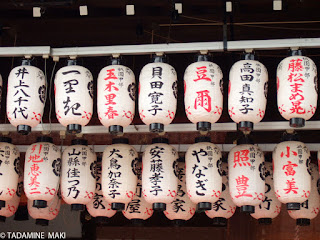
These are paper lanterns dedicated to Yasaka Shrine. The names on the papers are Maikos and Geishas working in Gion. Their work is to dance and sing on small Japanese restaurants.
This shrine is in Gion and famous for the gods of traditional Japanese arts. So Maikos and Geishas often go there to wish the further improvement of their performance.
Monday, March 19, 2007
Mixed food

Japanese culture is like this pasta. This pasta is Tarako flavored. Tarako means salted cod roe and goes well with pasta. We usually have eaten Tarako with boiled rice.
This combination is one of the most popular pastas in Japan, as well as pomodo and carbonara.
Japan has positively taken in other cultures, mixed them with Japanese culture and arranged them in our way.
By the way, the below photo is one of Japanese curry with boiled rice and it contains tofu. Japanese food is also added to Indian food.

Sunday, March 18, 2007
Cherry flowers

Pale pink covers all over Japan from late in March to the middle of April every year, when cherry blossoms come out and about 30 millions people, about one out of every four, are said to enjoy the viewing party of cherry blossoms, just eating and drinking under the trees.
The Japan Meteorological Agency(気象庁) has predicted the flowering dates of cherry blossoms at this year. But the authority largely corrected the dates and it officially apologized for the mistakes.
I think that Japan seem to be peaceful because the authority apologized for it and people in Japan are eagerly waiting for the coming out of the cherry flowers.
Saturday, March 17, 2007
A gate in a garden for tea house

This small is in a garden for tea house, is made of wood and bamboo and is installed on the small path following toward the tea house.
Tea houses, in general, are located on the most remote part of tea gardens and are very hard to find from outside the garden. This is why a host and guests of tea ceremony hold on the tiny house would like to do the ceremony peacefully, far from the daily life.
Now, the gate has, roughly speaking, three purposes.
The first purpose is, as the same as other gates, to keep people except hosts and guests away from the garden. Exactly speaking, they will easily be able to break the gate enter the garden over it. This gate softly and modestly rejects them to enter inside, just like a stone for keeping away, Sekimori-ishi.
The second one is to make people feel further from there to the small house than it really is. The division by the gate make people feel further to the house. Making them feel further slightly helps the house feeling like being in the tranquility outside the town.
The third is to change the remote space into a sacred space by fencing off. In terms of Japanese garden and architecture, going inward means reaching the sacred space in a sense. Much the same is true on the tea house and tea garden. Guests need to pass through some gates and openings to go to the tea house. They, at first, need to pass through the gate at the entrance of the site. After passing through it, they are to follow the tiny path in the garden. Some going-ahead after, they need to go through another gate like this again. Then, they are to reach the house. They have to pass through the tiny opening of the entrance to the inside of the house.
In this way, the gate has several meanings and divide the garden softly and modestly.
Friday, March 16, 2007
Wednesday, March 14, 2007
Tuesday, March 13, 2007
Slightly-misshapen grid of the traditional in Kyoto and the modern in Tokyo

This is a window of a tea house. This window was made up by leaving the wall un-plastered. The un-plastered wall was diverted into the window. The pattern of the grid can add the light to the unique expression, changing up to time.

On the other hand, this neon in grid shape is projected on the facade of CHANEL building. The slightly-distorted grid comes from the pattern of CHANEL suit.
Sunday, March 11, 2007
A kind of Buddhist image in Japan, Yakushiji Temple

This Buddhist image is not Buddha himself but one of many Buddhist gods. This is a god for curing injured or sick people and making them feel better. So people pray to the status for them. This status used to be covered with gold but now the gold has worn off the status totally. The status has been left because this temple had been enough money to buy gold for it. But the oxdized copper on the surface and the modest smile add the limpid but profound depths to the status.
I think this status is one of the greatest status in Japan.
Saturday, March 10, 2007
Tamasaburo Bando, one of the greatest Kabuki actors of the day


This person, dressed to the nine in a rather classical way, is not a woman but a man. But he is not a gay but a Kabuki actor.
He is Tamasaburo Bando and one of greatest Kabuki actors of the day.
Kabuki is performed by all men so he dresses and makes up like a woman.
Kabuki is one of Japanese traditional performing art, as well as Noh and Bunraku, and is the elegant marriage of performing, dancing and music. Three elements of the sound, color and moving makes up this art, like Opera performance in the Western.
Labels: art
Friday, March 09, 2007
Thursday, March 08, 2007
Wednesday, March 07, 2007
Tuesday, March 06, 2007
Monday, March 05, 2007
Sunday, March 04, 2007
Traditional city lights in Kyoto, Ponto-cho

This is called cho-chin(提灯) and adds some mild light to the city.
By the way, here is the mordern city lights in Tokyo
Have a nice weekend!!
Location by Google Map
Saturday, March 03, 2007
Use wood the same way as it was in the nature.

This photo is shot in an afternoon and a pillar of a building in Katsura Imperial Villa.
Sunlight on the face of pillar show that the knotty surface is facing to the south. This pillar faces in the same direction as it used to stand in a mountain before being cut down.
The surface of trees on the south, in general, has more branches than the one on any other directions. This allows the branches to get more sun rays to do photonic synthesis on the leaves and to supply nutrition to the tree.
Carpenters in Japan has believed that it is better for wooden buildings to put wooden pillars in the same direction just as they were in the nature. Because wood, even after being cut down from trees, has been alive.
Location by Google Map
Friday, March 02, 2007
Thursday, March 01, 2007
The theme day: Men at work, Otokoshi(男衆)

This photo is about Misedashi, a ceremony of greetings of fresh Maiko with a man to people who will work with her just after she finished the training period.
The man is called Otokoshi(男衆).
His daily work is to tie Maiko's sash to help her put on a kimono. Maiko's tie of kimono is about 7.5 meters length. It is heavier and longer than usual and man's power is needed to tie the sash.
1 (Porto (Portugal) ) -2 (Greenville SC (USA) ) -3 (Hyde (UK) ) -4 (Tenerife (Spain) ) -5 (Albuquerque, NM (USA) ) -6 (Stayton, OR (USA) ) -7 (Rotterdam (NL) ) -8 (Kuala Lumpur (Malaysia) ) -9 (London (England) ) -10 (Richmond, VA (USA) ) -11 (Sydney -Sally (Australia) ) -12 (Newcastle upon Tyne (England) ) -13 (Constanta (Romania) ) -14 (Evry (France) ) -15 (Lubbock, TX (USA) ) -16 (Szentes (Hungary) ) -17 (Villigen (Switzerland) ) -18 (Mumbai (India) ) -19 (Tel Aviv (Israel) ) -20 (Twin Cities, MN [USA] ) -21 (Jakarta (Indonesia) ) -22 (Houston -Candice & Megan, TX (USA) ) -23 (Budapest (Hungary) ) -24 (Singapore - Zannnie (Singapore) ) -25 (Dubai (UAE) ) -26 (Singapore -Keropokman (Singapore) ) -27 (Madrid -Dsole (Spain) ) -28 (Mazatlan -Kate (Mexico) ) -29 (Nelson (New Zealand) ) -30 (Vantaa (Finland) ) -31 (Kyoto (Japan) ) -32 (Tokyo (Japan) ) -33 (Joplin, MO (USA) ) -34 (Auckland (New Zealand) ) -35 (Sequim, WA (USA) ) -36 (Menton (France) ) -37 (Minneapolis, MN (USA) ) -38 (Istanbul (Turkey) ) -39 (Sydney -Nathalie (Australia) ) -40 (Sharon, CT (USA) ) -41 (Seattle, WA (USA) ) -42 (Anderson, SC (USA) ) -43 (Monte Carlo, (Monaco) ) -44 (Milano, (Italy) ) -45 (Grenoble (France) ) -46 (Wailea, HI (USA) ) -47 (Guelph, ON (Canada) ) -48 (Melbourne - John (Australia) ) -49 (New York City (USA) [Ming_the_Merciless] ) -50 (Cebu (Philippines) ) -51 (Bandung (Indonesia) ) -52 (Antigua Guatemala (Central America) ) -53 (Hamburg (Germany) ) -54 (London -Jonemo (UK) ) -55 (Hong Kong ) -56 (Stavanger (Norway) ) -57 (Paris (France) ) -58 (Naples, Florida (USA) ) -59 (Saarbrücken (Germany) ) -60 (Shanghai (China) ) -61 (Quito (Ecuador) ) -62 (Zurich (Switzerland) ) -63 (Joensuu ( Finland ) ) -64 (Aliso Viejo, CA (USA) ) -65 (Cheltenham (England)) -
Location by Google Map


